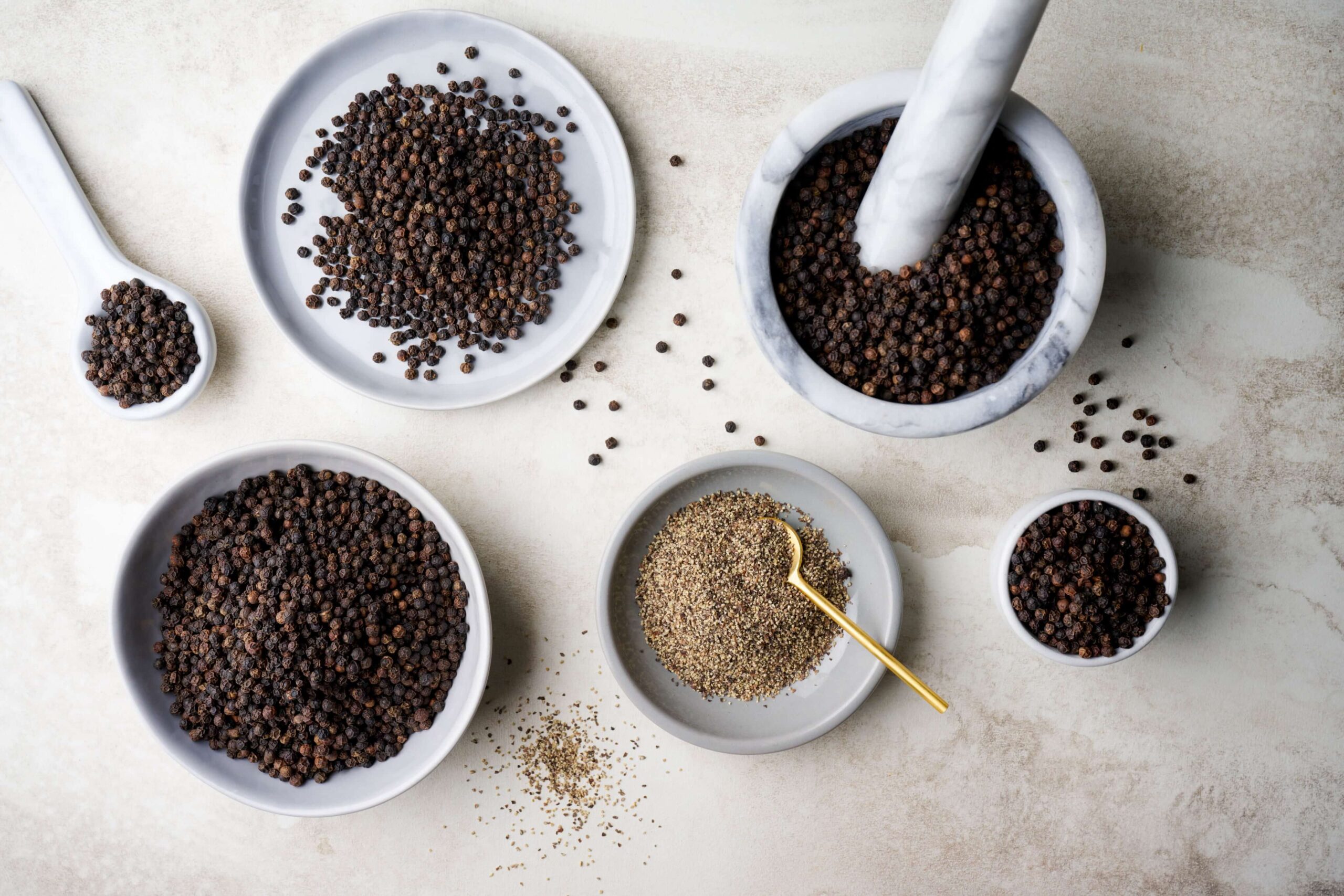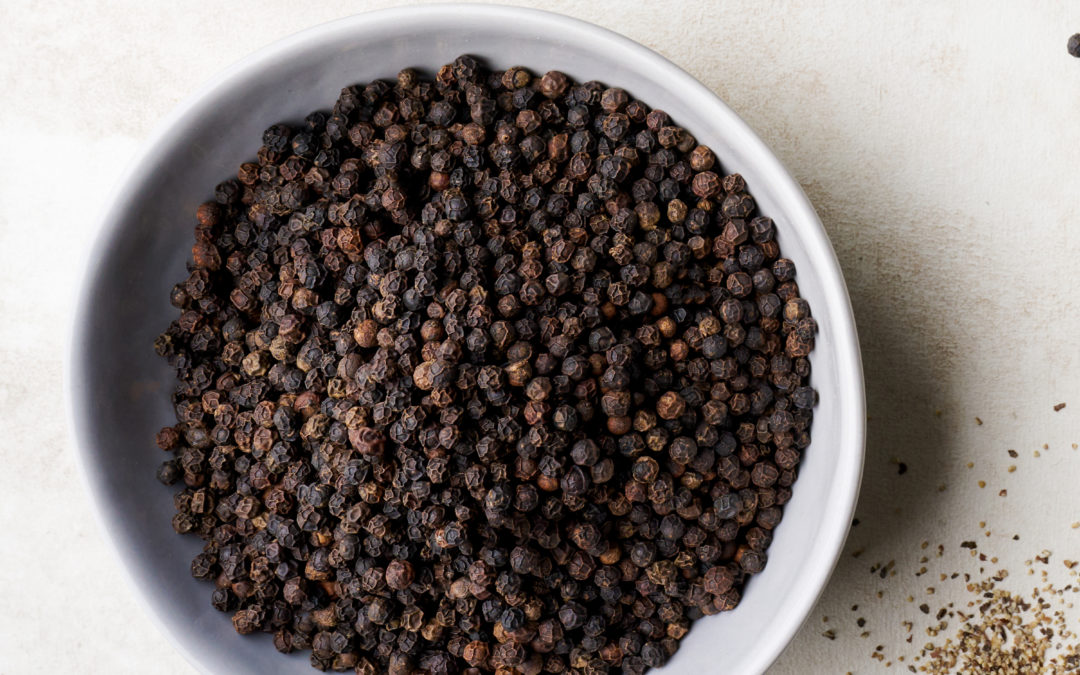Black pepper is a longstanding staple in homes, restaurants, and kitchens around the world, lending its unmistakable flavor to everything from pork chops to pineapple. But although it is the most commonly used spice on the globe today, this ancient spice wasn’t always so accessible.
In this blog, we’ll discuss the very rich history, origins, and common uses for black pepper.
Flavor
The flavor of black pepper is unmistakable. It is best described as woody, piney, warm, and earthy, with a slightly pungent finish. The main active ingredient is the natural chemical piperine, which gives the spice its signature heat and subtle, spicy bite.
With a vibrant flavor that awakens the taste buds, this standout spice has the unique ability to enhance and accentuate the existing flavors of food without overpowering them. This is why black pepper pairs so well with such a wide variety of foods.
Black pepper offers fragrance, heat, and a complex depth of flavor that is made only more evident when it’s layered with other spices.
Appearance
Black pepper comes from the Piper nigrum L. plant. This perennial vine produces small berries, or peppercorns, which are harvested and dried.
While you may see peppercorns in different colors, they may come from the dried fruit of the same vine. Their final color depends on when they’re harvested and how they’re processed.
For example:
- Green peppercorns are picked before they have ripened. Then, they are air- or freeze-dried to preserve their color.
- Black peppercorns are picked while they are not fully ripe; then, they are dried. The skin wrinkles and turns from dark brown to black.
- White peppercorns are allowed to ripen before harvesting. Once harvested, they are soaked. Then, the dark skins of the peppercorn are removed, and the light core is dried.
When black peppercorns are ground, their signature black and white speckled appearance comes from a blend of the dark outer shell of the peppercorn and light inner core.
History
 For centuries, black pepper was a luxury spice that was so highly prized it was referred to as “black gold” and the “king of spices”. Originating in India, black pepper was the object of desire for explorers and helped to fuel critical world exploration as journeyers searched for a direct western trade route from Europe to India.
For centuries, black pepper was a luxury spice that was so highly prized it was referred to as “black gold” and the “king of spices”. Originating in India, black pepper was the object of desire for explorers and helped to fuel critical world exploration as journeyers searched for a direct western trade route from Europe to India.
Historically, this famed spice was used as a status symbol, a natural medicine, a wealth-builder across continents, and a viable currency which some would use to pay their taxes.
Origins/Quality Sourcing
Black pepper is native to the Western Ghat Mountains in India, but is now cultivated across continents. Today, it is grown throughout Southeast Asia, Africa, Vietnam, Brazil, and the Western Hemisphere.
At Pacific Spice, we are dedicated to sourcing the highest quality spices. Our black pepper is sourced from reputable, approved sources ensure a flavorful and dependable addition to your favorite dishes.
Storing
Black pepper should always be tightly sealed and stored in a cool, dry, dark place; above ground and away from the wall. When it’s stored properly, ground product can stay fresh for up to one year or more, and whole peppercorns can stay fresh for much longer.
Uses
When it comes to using black pepper in the kitchen, your only limit is your imagination. Black pepper is a cornerstone spice in meat rubs and marinades, and can be sprinkled over just about anything, from stir fry, to pasta, salad, vegetables, and even some desserts.
Here are some easy and creative ways to use this spice to liven up your meals:
- Sprinkle it over a freshly sliced avocado
- Finish off your homemade chicken stock with a final dusting
- Use it to balance out the richness of a buttermilk-based dressing.
PSC Black Pepper
At Pacific Spice, we sell whole peppercorns and ground black pepper in various mesh sizes, ranging from very coarse to very fine.
- Whole – Perfect for tabletop grinders, broths, and pickling brines.
- Cracked – Use for peppered steak or in a salad for visual appeal and rich flavor.
- Coarse – Bold in flavor and visibility. Perfect in broiled dishes.
- Medium – Great for chicken, chops, and fish.
- 24 Mesh – Adds bite to your sauces and stews.
- 28 Mesh – Great for potatoes, braised meats, and tabletop pepper shakers.
- Regular (30 Mesh) – The most versatile. Add to chowders or hamburgers.
- Fine – Distributes flavor evenly. Ideal for sauces.
If you’re interested in ordering from PSC, contact us about our products! When you source from us, we will help you determine the proper mesh size for your desired function, flavor, and consistency.


I’d like a quote on 28 mesh black pepper I’d like a quote from 100 lbs up to 1 ton